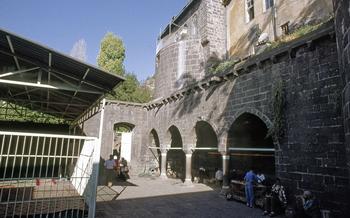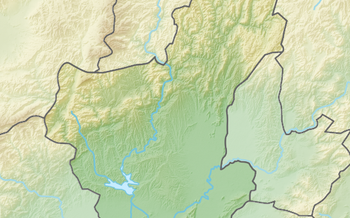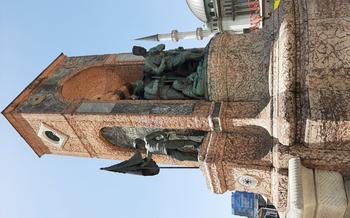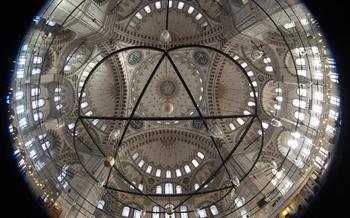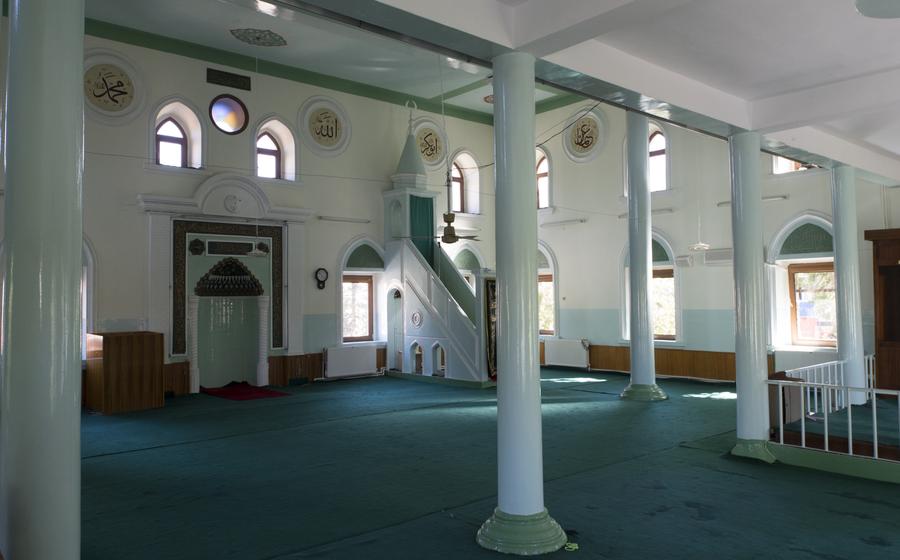
The Grand Mosque of Isparta
- History of the Grand Mosque of Isparta
- Architectural Features
- Interior Decor and Ambiance
- Religious Significance
- Cultural Importance
- Tourism and Accessibility
- Visiting Tips
- Prayer Times and Services
- Local Customs and Traditions
- Historical Events and Personalities
- Art and Architecture Appreciation
- Photography and Social Media
- Local Cuisine and Hospitality
- Nearby Attractions and Activities
- Insider Tip
History of the Grand Mosque of Isparta
The Grand Mosque of Isparta, a magnificent architectural marvel, stands as a testament to the rich history and religious devotion of the city. Its construction dates back to the 15th century, during the reign of the Ottoman Empire. The mosque was commissioned by the then-governor of Isparta, Hızır Bey, who played a pivotal role in its design and construction. The mosque's intricate architecture and stunning ornamentation were meticulously crafted by skilled artisans and builders of the era. Over the centuries, the Grand Mosque has undergone several restorations and renovations to preserve its grandeur and architectural integrity. These efforts have ensured that this iconic landmark continues to inspire awe and devotion among visitors and worshippers alike.
Architectural Features
The Grand Mosque of Isparta stands as a testament to the architectural prowess and intricate craftsmanship of the era in which it was built. Its overall design exudes a sense of harmony and symmetry, with a rectangular plan and a central courtyard that serves as a tranquil oasis. The mosque's minaret, a symbol of Islamic architecture, rises majestically towards the heavens, its slender form adorned with intricate carvings and geometric patterns. The dome, a defining feature of the mosque, is a marvel of engineering and aesthetics, showcasing intricate ornamentation and calligraphy that captivates the eyes of all who behold it. Inside the mosque, the mihrab, a niche indicating the direction of Mecca, and the minbar, a pulpit from which sermons are delivered, are adorned with exquisite carvings and inscriptions, further enhancing the mosque's spiritual ambiance.
Interior Decor and Ambiance
The interior of the Grand Mosque of Isparta exudes a serene and spiritual atmosphere, inviting visitors to find solace and connect with their faith. The walls are adorned with intricate calligraphy and verses from the Quran, adding to the mosque's sacred ambiance. The chandeliers and lighting fixtures, with their unique designs and patterns, illuminate the space with a warm and inviting glow, creating a sense of tranquility and awe. The prayer rugs and carpets, meticulously chosen for their colors and designs, contribute to the overall aesthetic of the mosque, enhancing the spiritual experience of worshippers.
Religious Significance
The Grand Mosque of Isparta holds immense religious significance for the Muslim community and plays a vital role in the religious and cultural life of the city. It is a revered place of worship where locals and visitors alike gather to perform their daily prayers and seek spiritual guidance. The mosque serves as a hub for religious education and community events, fostering a sense of unity and belonging among the faithful.
During the holy month of Ramadan, the Grand Mosque buzzes with activity as worshippers gather for Taraweeh prayers and special iftar meals. The mosque's spacious prayer hall and tranquil ambiance create a serene and contemplative environment, allowing worshippers to fully immerse themselves in their devotion.
The mosque also serves as a venue for religious lectures, workshops, and seminars, where renowned scholars and Islamic experts share their knowledge and insights with the community. These events provide a platform for religious discourse, promoting spiritual growth and understanding.
Beyond its role as a place of worship, the Grand Mosque holds deep cultural and historical significance for the people of Isparta. It stands as a testament to the city's rich Islamic heritage and is a source of pride for the local community. The mosque's enduring presence has shaped the cultural identity of Isparta, making it an integral part of the city's fabric.
Cultural Importance
The Grand Mosque of Isparta stands as a testament to the city's rich Islamic heritage and culture. Its architectural grandeur and spiritual significance have made it a symbol of pride and identity for the local community. The mosque serves as a central gathering place, not only for religious observances but also for cultural events and community gatherings.
During significant Islamic holidays such as Ramadan and Eid, the mosque becomes a hub of activity, where worshippers gather for special prayers, communal meals, and celebrations. The mosque's courtyard and prayer hall are adorned with colorful decorations, and the air is filled with the sounds of devotional recitations and joyful greetings.
Beyond its religious significance, the Grand Mosque also plays a crucial role in promoting interfaith dialogue and understanding. Through guided tours and educational programs, the mosque welcomes visitors from all backgrounds and faiths, fostering a spirit of tolerance and respect. The mosque's architectural features and historical significance serve as a bridge between different cultures, inviting visitors to explore the beauty and diversity of Islamic art and architecture.
Tourism and Accessibility
The Grand Mosque of Isparta is a significant tourist attraction, drawing visitors from around the world to admire its architectural grandeur and spiritual significance. The mosque is easily accessible, located in the heart of the city and within walking distance from various hotels, restaurants, and shops. Visitors are welcome to explore the mosque during its open hours, and there are no restrictions on entry for non-Muslims. Guided tours are available for those who wish to learn more about the mosque's history, architecture, and religious significance. Information brochures and pamphlets are also provided to assist visitors in their exploration. The mosque is well-equipped with facilities and amenities for visitors, including restrooms, prayer rooms, and a courtyard for relaxation.
Visiting Tips
To fully appreciate the tranquility and sanctity of the Grand Mosque, it is advisable to visit during off-peak hours, such as early mornings or late evenings, when the crowds are fewer. This will allow you to immerse yourself in the spiritual ambiance and truly connect with the mosque's serene atmosphere.
When visiting the mosque, it is imperative to observe the appropriate dress code and etiquette. Modest attire that covers the shoulders, knees, and chest is recommended for both men and women. Additionally, it is customary to remove your shoes before entering the prayer hall as a sign of respect.
Photography is generally permitted within the mosque, but it is crucial to be mindful of other worshippers and avoid capturing images that may disrupt their devotions. Flash photography and the use of tripods are typically not allowed, so it is best to use natural light and be discreet when taking photographs.
The Grand Mosque is easily accessible by public transportation, making it convenient for visitors to reach. There are several bus stops and taxi stands located nearby, ensuring that getting to and from the mosque is hassle-free.
Prayer Times and Services
The Grand Mosque of Isparta offers a serene and welcoming environment for worshippers of all backgrounds. Daily prayers are held at specific times throughout the day, providing an opportunity for the community to come together in devotion. Visitors who wish to participate in congregational prayers are welcome to join the worshippers and experience the spiritual essence of the mosque. The mosque also provides religious services and guidance for visitors, including assistance with performing ablutions and other religious rituals. Islamic literature and resources are available for those who wish to deepen their understanding of the faith. The mosque's facilities are designed to cater to the needs of worshippers, ensuring a comfortable and fulfilling experience.
Local Customs and Traditions
When visiting the Grand Mosque of Isparta, it is essential to be mindful of local customs and traditions to show respect for the religious and cultural significance of the site. Here are some important customs to keep in mind:
-
Removing Shoes: Before entering the mosque, it is customary to remove your shoes and place them neatly on the designated shoe racks. This practice is a sign of respect and cleanliness, as it helps to keep the mosque's interior clean and free of dirt and debris.
-
Greetings and Respect: When encountering other worshippers in the mosque, it is customary to greet them with a friendly "Selamun Aleykum" (Peace be upon you). This greeting is a sign of respect and acknowledges the shared faith and brotherhood among Muslims.
-
Silence and Reverence: Inside the mosque, it is essential to maintain silence and reverence to create a peaceful and conducive environment for prayer and contemplation. Avoid loud conversations, laughter, or any behavior that may disturb others' worship.
-
Respecting Local Customs: It is important to be respectful of local customs and traditions, even if they may differ from your own. This includes dressing modestly, avoiding revealing clothing, and being mindful of your behavior and actions within the mosque.
Historical Events and Personalities
The Grand Mosque of Isparta has witnessed numerous significant historical events throughout its existence. One notable event is the visit of the Ottoman Sultan Abdul Hamid II in 189During his visit, the Sultan ordered the construction of a new minaret for the mosque, which still stands today as a testament to his patronage.
Another significant event associated with the mosque is the Turkish War of Independence, which took place from 1919 to 192During this period, the mosque served as a gathering place for local resistance fighters and a symbol of Turkish resilience against foreign occupation.
The mosque has also been closely associated with several influential religious figures and scholars throughout history. One of the most notable figures is the renowned Islamic scholar and mystic, Mevlana Celaleddin Rumi. Rumi is said to have visited the mosque on several occasions and delivered sermons that inspired and enlightened the local community.
The history of the Grand Mosque of Isparta is deeply intertwined with the lives and stories of these historical figures and events, making it a site of immense cultural and historical significance.
Art and Architecture Appreciation
The Grand Mosque of Isparta showcases a unique architectural style that blends traditional Islamic elements with modern design principles. Its distinctive features, such as the intricate carvings on the facade and the elegant dome, reflect the skill and artistry of its creators. Visitors can appreciate the significance of the mosque's design and ornamentation, which symbolize the fusion of religious and cultural influences in the region. The intricate craftsmanship and artistry displayed in the mosque's construction offer an opportunity to learn about Islamic art and architecture. Each detail, from the geometric patterns to the calligraphy, holds cultural and historical significance, making the Grand Mosque a treasure trove of architectural wonders.
Photography and Social Media
The Grand Mosque of Isparta, with its stunning architecture and intricate details, offers ample opportunities for photography enthusiasts. Visitors are welcome to capture the beauty of the mosque through their lenses, but it is essential to be respectful of the sacred nature of the site. While taking photographs, remember to avoid disturbing worshippers or obstructing their prayers.
When sharing your photos on social media, consider using relevant hashtags and geotagging to help promote the mosque and encourage others to visit. This can help raise awareness about the mosque's historical and cultural significance, inspiring more people to explore its beauty and spirituality.
By using social media responsibly, you can contribute to the preservation and appreciation of the Grand Mosque of Isparta, sharing its splendor with the world while respecting its sanctity.
Local Cuisine and Hospitality
The Grand Mosque of Isparta is not only a spiritual and architectural marvel but also a gateway to experiencing the warmth and hospitality of Turkish culture. Visitors can savor the delights of traditional Turkish cuisine at the numerous restaurants and cafes located just a short stroll from the mosque. Indulge in mouthwatering kebabs, aromatic Turkish coffee, and the irresistible sweetness of baklava, all while soaking in the vibrant atmosphere of Isparta's culinary scene.
Embrace the Turkish tradition of sharing meals and conversations by striking up friendly chats with locals. Engage in lively discussions about the mosque, the city's history, or simply share travel stories and experiences. The locals' genuine warmth and eagerness to connect with visitors create a welcoming and inclusive environment.
Don't miss the opportunity to savor the iconic Turkish tea, a symbol of hospitality and camaraderie. Sip on a refreshing glass of çay while enjoying the company of fellow travelers or locals, immersing yourself in the essence of Turkish culture. The çay gardens and cafes near the mosque offer a tranquil setting to relax, unwind, and soak up the local ambiance.
Nearby Attractions and Activities
The Grand Mosque of Isparta is strategically located in the heart of the city, offering visitors the opportunity to explore a wealth of nearby attractions and activities. Within walking distance, visitors can immerse themselves in the city's rich history and culture by visiting the Isparta Museum, which houses a diverse collection of artifacts and exhibits showcasing the region's past. For those seeking a vibrant shopping experience, the bustling Isparta Bazaar is a must-visit, offering an array of traditional Turkish handicrafts, souvenirs, and local delicacies.
Just a short drive away, nature enthusiasts can escape to the scenic Lake Egirdir, renowned for its crystal-clear waters and picturesque surroundings. Visitors can embark on a leisurely boat tour, marvel at the stunning views of the Taurus Mountains, or simply relax on the tranquil shores. For those seeking adventure, the nearby Kovada National Park offers breathtaking hiking trails, cascading waterfalls, and diverse flora and fauna.
To fully grasp the essence of Isparta, visitors should not miss the opportunity to indulge in the local cuisine. The city boasts an array of traditional Turkish restaurants and cafes, serving mouthwatering dishes such as Isparta kebabs, keşkek, and gözleme. Savor the flavors of Turkish coffee and tea while engaging in lively conversations with the friendly locals.
Whether you're a history buff, a nature lover, or a culinary enthusiast, the vicinity of the Grand Mosque of Isparta offers an abundance of experiences to enrich your visit. Embrace the opportunity to explore the city's hidden gems, venture into the surrounding natural wonders, and immerse yourself in the vibrant local culture.
Insider Tip
-
Explore the hidden courtyard behind the mosque for a peaceful retreat. This tranquil oasis offers a serene escape from the bustling city, where you can relax and reflect in solitude.
-
Attend the evening prayers during Ramadan for a unique and spiritual experience. Immerse yourself in the vibrant atmosphere of Ramadan, witnessing the collective devotion and camaraderie among worshippers.
-
Learn a few basic Turkish phrases to interact with locals and enhance your visit. Simple greetings and expressions of gratitude can go a long way in fostering connections and creating a more meaningful experience.
-
Take advantage of the local transportation system to easily explore the city. Isparta's public transportation network is efficient and affordable, allowing you to conveniently travel to other attractions and landmarks.
